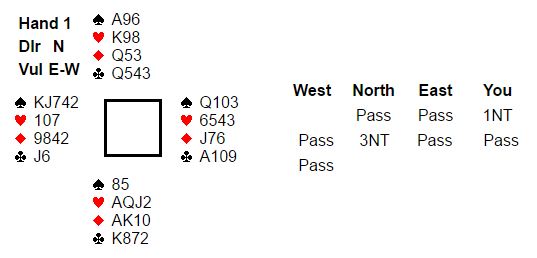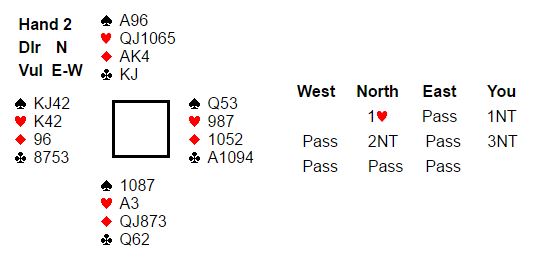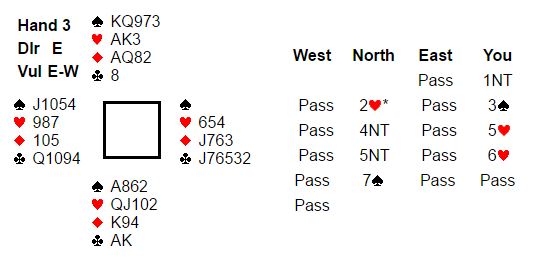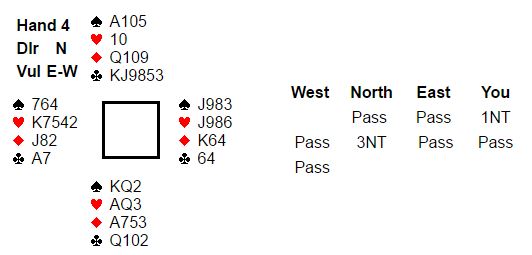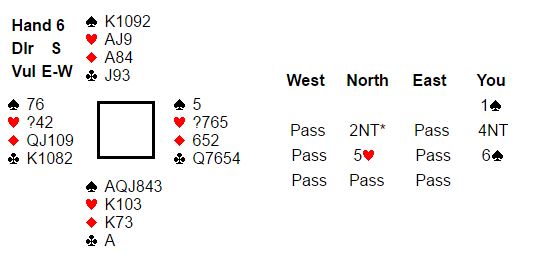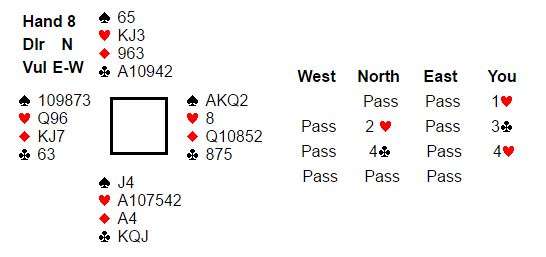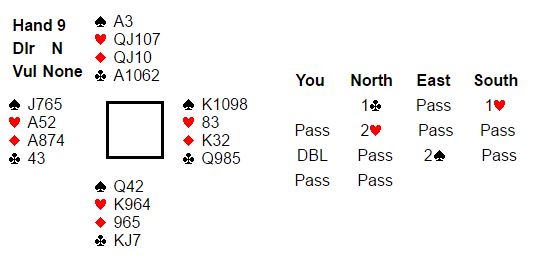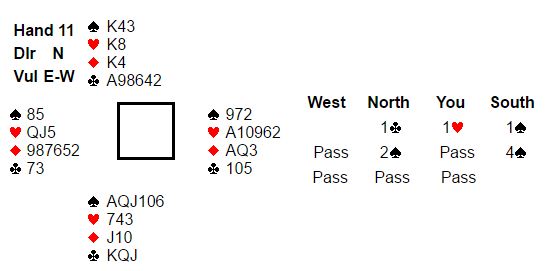Source: Basic Bridge Techniques By Larry Matheny
In this article we are going to examine some concepts with which the successful player needs to be familiar.
THE HOLDUP
West leads his fourth best spade. Plan your play.
SOLUTION: You have only eight tricks so you must develop a club trick. First you must duck the first two spade leads and win the third. Then you must hope that East holds the ace of clubs. If East holds a fourth spade, the suit is divided 4-4 and you make the hand. If the club ace is in the West hand and he has five spades, you cannot make the contract.
Additional note: The small doubleton spade should not deter you from opening 1NT. If you open 1 , you will often have no good rebid.
, you will often have no good rebid.
COUNT YOUR TRICKS
West leads his fourth best spade. Play your play.
SOLUTION: Although the spade deuce suggests a four-card suit, there is no reason not to holdup and win the second spade. A quick tally of your tricks shows only seven: one spade, one heart, and five diamonds. Although the heart suit is attractive, unless the king is doubleton in the East hand, taking a winning heart finesse will only give you one more trick and if it loses will set up a fifth trick for the defense. Playing on clubs will give you the two extra tricks you need.
I sat East on this hand and declarer won the first spade, took the losing heart finesse, and promptly went down in an ice cold contract.
*Jacoby Transfer
West leads his fourth best club. Plan your play.
SOLUTION: The only thing that can defeat this hand is a 4-0 spade break. Since you cannot pick up the suit if East has four spades, your first play must be the ace of spades. Now you can pick up West’s trumps. The initial play of a low spade to dummy will quickly have North busy looking for a new partner. Actually this shouldn’t be titled “Safety Play” because it is the ONLY play.
Hint: Look for the problem before you play to trick one.
Many rubber bridge players have trouble making the necessary adjustments to be successful at duplicate bridge. Using matchpoint scoring it is rarely correct to head for a minor suit game. It just doesn’t score as well. This hand is a typical example. Those in 5 will make four or five depending upon the opening lead and the diamond guess. Even those successful in 5
will make four or five depending upon the opening lead and the diamond guess. Even those successful in 5 will only score +400. Assuming a heart lead in 3NT, those declarers have an easy eleven tricks for +460. Without a heart lead there are still ten certain tricks for +430.
will only score +400. Assuming a heart lead in 3NT, those declarers have an easy eleven tricks for +460. Without a heart lead there are still ten certain tricks for +430.
Be certain there is a wide-open suit before bypassing game in NT. Even then the opponents may not be able to cash five tricks before you have nine.
OPEN 1NT AND 2NT WITH SEMI-BALANCED HANDS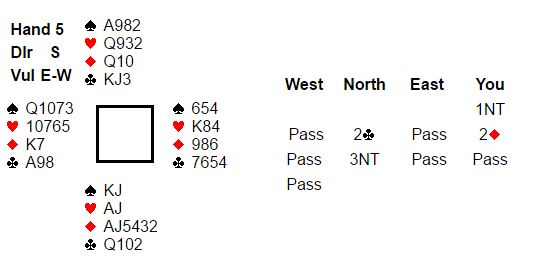
One reason for opening 1NT is to show partner the strength of your hand immediately. Another plus is that it eliminates rebid problems. If you open the South hand 1 , you don’t have a good rebid after North’s 1
, you don’t have a good rebid after North’s 1 response. You have the values for 3
response. You have the values for 3 but your suit is not good enough for a jump rebid. And it’s usually right for the stronger hand to declare the contract.
but your suit is not good enough for a jump rebid. And it’s usually right for the stronger hand to declare the contract.
Looking again at the comparison of 3NT and five of a minor, those in notrump will likely score +460 while those in 5 will be +400.
will be +400.
*Forcing Spade Raise
West leads the queen of diamonds. It appears you have a diamond loser so you must not lose a heart. How do you continue?
SOLUTION: It doesn’t matter who holds the heart queen. Win the diamond in your hand, unblock the club ace, and play a trump to dummy followed by a club ruff. Another trump to dummy allows you to ruff dummy’s last club. Next you simply play ace and another diamond. Whoever wins must now either lead a heart or allow you to discard a heart as you ruff in the other hand.
This is a standard ELIMINATION play. Guessing is for the young and the very lucky.
West leads the heart nine: sitting East, what do you play to trick one?
SOLUTION: You know from the opening lead and bidding that South holds the AJX of hearts. If you play the queen (or king) at trick one, South will duck and win the second heart. This will leave West with no heart to lead when he is in with the club ace. Therefore, you must overtake with the ten and force South to win the first heart. When West wins the club ace he returns his remaining heart. When you win the club king, you can cash your hearts defeating the contract. The opportunity for this play occurs frequently.
This is a good example of why you must stop and think about the entire hand before you play to trick one. Look at the opening lead and remember the bidding.
East won the opening lead of the ten of spades with the queen and cashed the king before switching to a low diamond. You win the ace and have to decide how to play the trump suit. With no other information, you would play the top two honors but let’s stop and recall the auction. East passed at his first opportunity and had shown up with the top three spade honors. You also realize if West held the top three diamonds he would have led one rather than a spade. This marks East with a diamond honor, probably the queen. Armed with this information, you should play the heart ace followed by a low heart to the jack. Next you draw the last trump and make eleven tricks by discarding you diamond loser on the long club suit.
Notice how easy East made it for declarer to place the high cards. A better play would be to win the first spade with the ace then play the queen in an attempt to convince you the king was in the West hand.
Now you are in the West chair. This is a typical auction in a pairs event. It is almost ALWAYS correct for West to balance in this auction. The “rules” are 1) the opponents have a fit, and 2) they have stopped below game. Every now and then you will walk into trouble but letting them play at the two-level with a fit will usually give you a bad result.
On this particular hand, your partner will go down one trick for –50. The opponents can make +110 or +140 depending upon the club guess. Even if you get doubled (highly unlikely), your –100 is a good result. It is important for East to realize that you are bidding the combined values of the E/W cards. You know East is marked with points because the opponents stopped short of game and if the opponents bid on to the three-level, East should not bid again. In fact, the goal is to push the opponents to the next level. They may make it but it’s better than allowing them to play at the two-level.
This is a very important matchpoint (pairs) technique. If you go –110, you will usually get very few matchpoints.
ANOTHER “LISTEN TO THE AUCTION”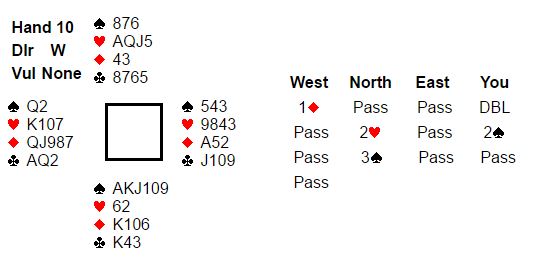
West led the queen of diamonds won by East with the ace. East shifts to the jack of clubs and the opponents quickly have four tricks. West exits with a heart; how do you make this contract?
SOLUTION: Just REMEMBER THE AUCTION and the rest is easy. East passed his partner’s opening bid and has shown up with the diamond ace and the jack of clubs. This means the heart king and the spade queen are both in the West hand. You must play for the spade queen to drop under your ace or king.
In response to your overcall, West leads the queen of hearts. Declarer plays low from dummy and you follow with?
Solution: Of course you immediately see the danger in dummy’s long club suit and desperately want partner to shift to a diamond. So you discourage a continuation by signaling with the heart deuce. West makes the obvious switch to diamonds and the contract is defeated. It is easy to see that if West had continued with a second heart, declarer would win any continuation, draw trumps, and discard his remaining red cards on the club suit. In fact, you would have to cash the diamond ace at trick three just to prevent the overtrick.
There was nothing difficult about this hand. Just remember that every card you play sends a message. Most new players in the West chair would be delighted they won the first trick and couldn’t wait to lead another heart.
Don’t be mechanical: Watch the cards.
HAVE A REASON TO BID
There are several reasons to enter the auction after the opponents have opened the bidding. You might want to try to buy the contract, suggest a sacrifice, impede the opponents, or make a lead-directing overcall. However, some players enter for no reason other than they can.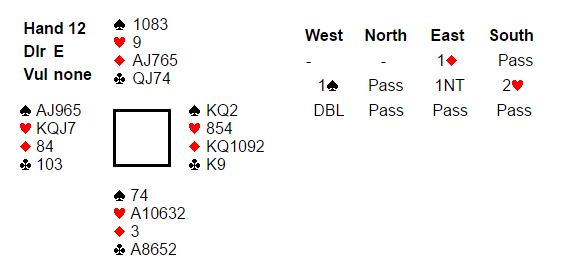
East-West were on their way to a 4 contract when South decided to enter the auction. West doubled to end the bidding.
contract when South decided to enter the auction. West doubled to end the bidding.
West led a diamond and declarer was lucky to find six tricks for down two. Since the distribution doomed the spade contracts, this score of +300 was a top for East-West. On defense against the East-West spade contracts, the North-South pairs usually took the first seven tricks.
It is difficult to understand why South entered the auction. At least North thought so.
Esta entrada también está disponible en: Spanish


